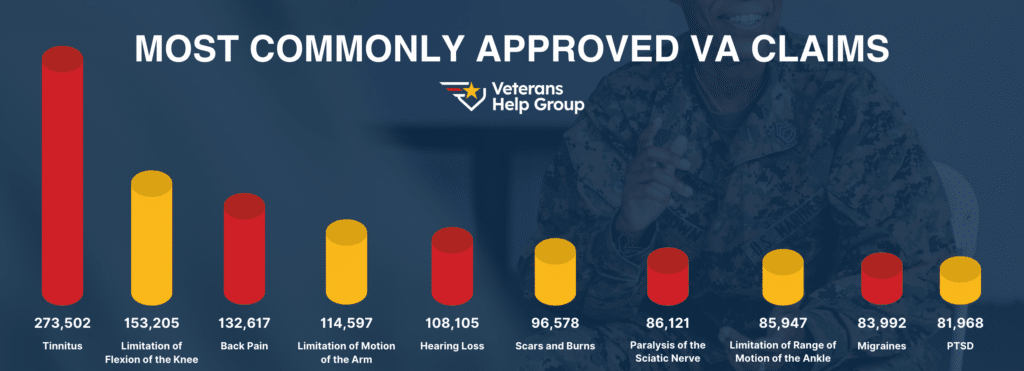
Table Of Contents
Most Commonly Approved VA Claims
– MATT SAUERWALD, VICE-PRESIDENT, VETERANS HELP GROUP
Matt Sauerwald has spent years dedicating his time to Veterans seeking help with their VA disability benefits. Matt proudly represents thousands of veterans with his expert knowledge of the VA disability application process and the Veterans Administration.
Today, Matt will explain the most commonly approved VA claims.
Filing VA claims with Veterans Affairs should not be a challenge, however, many veterans have found it to be a difficult process. To have a VA claim approved, you need to prove you have a current disability causing functional limitations and that there is a connection between that condition and an in-service event or another service-connected condition. A veterans disability advocate can help you get a claim approved.

The Top Ten Most Commonly Approved VA Claims:
The Veterans Administration recently submitted a report to Congress outlining the most common claims approved by the VA.
Here Are The Top Ten:
1. Tinnitus (273,502 new approvals in 2024)
Tinnitus is a condition that causes ringing in the ears or other sound such as buzzing or hissing. In most cases, only the person suffering from tinnitus is aware of the sound. However, with a certain rare type of tinnitus a sound is emitted that can be heard by others.
Tinnitus has a variety of possible causes, several of which may be service connected. These include head injuries, noise exposure, and certain types of infections. Currently, the only VA disability rating available for tinnitus is 10%. However, it is anticipated that in 2025, the rating schedules will change and tinnitus will no longer qualify for a separate rating.
2. Limitation of Flexion, Knee (153,205 new approvals in 2024)
Limited flexion of the knee is a technical way of saying that you cannot bend your knee fully and normally. This condition may be caused by an injury, arthritis, or even surgical intervention for another condition.
The VA disability rating that may be assigned for this condition depends on the degree of limitation.
3. Lumbosacral or Cervical Strain (Back Pain) (132,617 new approvals in 2024)
Lumbosacral strain impacts the lower back and cervical strain the upper back. Both can be caused by an injury, by overexertion, or sometimes by having been in an unnatural position for sustained periods or repetitively.
The possible VA disability rating for this condition depends on the degree of limitation. The rating may be as low as 10% or as high as 100%, but is usually 20% or below.
4. Limitation of Motion of the Arm (114,597 new approvals in 2024)
Like other musculoskeletal conditions, limited motion of the arm may be caused in many different ways, including injury, arthritis, and neurological conditions.
Limited motion of the arm is rated differently depending on a wide range of factors, including whether the full arm or only the forearm is affected, whether the dominant arm is affected, and the degree of limitation. Ratings for limitation of motion of the whole arm range from 20% to 40%, while the rating for extreme limitation of flexion of the forearm may be higher.
5. Hearing Loss (108,105 new approvals in 2024)
Hearing loss may result from noise exposure during military service, from certain types of injuries, and even from infectious disease. Service-connected hearing loss may be assigned a VA disability rating anywhere between 0% and 100%, depending on the degree of hearing loss. The VA requires specific testing to determine the appropriate rating.
6. Scars and Burns (96,578 new approvals in 2024)
Burn scars are rated based on various characteristics of the scar or scars, including number, location, size and whether the scars are accompanied by underlying tissue damage, pain or instability. Significant scarring of the face, head, or neck may qualify for a rating of up to 80%, while smaller and less visible scars may be rated as low as 10%.
7. Paralysis of the Sciatic Nerve (86,121 new approvals in 2024)
Paralysis of the sciatic nerve is most commonly caused by an injury. The condition may range from mild, incomplete paralysis with symptoms such as numbness to complete paralysis. Complete paralysis of the sciatic nerve can cause weakness in the knee, muscle weakness, pain, loss of sensation, weak or abnormal reflexes and foot dropping.
Depending on the severity, paralysis of the sciatic nerve may be rated at 10%, 20%, 40%, 60% or 80%.
8. Limitation of Range of Motion of the Ankle (85,947 new approvals in 2024)
Like the other limitation of motion conditions on this list, limitation of movement of the ankle can be caused in many ways, including injury and arthritis. Also like the other similar conditions, limited range of motion of the ankle is rated based on the severity of the limitation. Possible ratings range from 10% to 40%.
9. Migraines (Headaches) (83,992 new approvals in 2024)
Migraine isn’t “just a headache.” The condition can be debilitating. Certain veterans suffer from migraines at a much higher rate than the general population. For example, one study showed that 36% of OEF/OIF veterans experienced migraines.
Migraine alone may be rated 0%, 10%, 30% or 50%. However, migraine may be secondary to other service-connected conditions and may have secondary conditions associated with the condition. So, the veteran’s overall disability rating may be higher.
10. Post-Traumatic Stress Disorder (PTSD) (81,968 new approvals in 2024)
Overall, veterans experience PTSD at only slightly higher rates than the general public. However, veterans of certain operations, including OEF/OIF and the Persian Gulf War, suffer from PTSD at much higher rates.
PTSD is rated based on the General Rating Formula for Mental Disorders. If you suffer from more than one service-connected mental health condition, your symptoms will be considered together to arrive at a single rating, which may be 0%, 10%, 30%, 50%, 70%, or 100%.
The way mental health conditions are rated is also expected to change in 2025.
Are Some VA Claims More Commonly Approved Than Others?
Yes, some VA claims are more commonly approved than others. Service connection for tinnitus is granted more frequently than any other disability. More than 2.3 million veterans have benefits for tinnitus. Hearing loss may be more difficult to get approved despite being the second most commonly approved disability.
How A VA Disability Advocate Can Help
When you have questions about filing a claim with the VA or need to appeal a decision regarding your VA benefits, speak to a veterans disability expert from the Veterans Help Group. Call us today at (855) 855-8992 to schedule a free consultation to discuss your VA disability benefits or click here.
Learn More Below:
- VA Disability Benefits For Bruxism: Secondary Service Connection
- VA Ratings For IBS (Irritable Bowel Syndrome)
- Dental Benefits and VA Disability Ratings For Teeth
- How To Speed Up Your VA Disability Claim
- How To Apply For VA Disability Benefits
- SSD For Veterans
- VA Disability For A Heart Condition
- Rhinitis VA Disability Claims
- VA Disability For Your Ankle Injury

VA Caregiver Support Program: What Veterans and Families Should Know
VA Caregiver Support Program: What Veterans and Families Should Know Written by Adam Zider: Senior...

VA Disability Benefits and Tax Exemptions: What You Should Know
VA Disability Benefits and Tax Exemptions: What You Should Know Written by: Schuyler Swanton,...

Veterans Help Group In The Community
Veterans Help Group in the Community Written by: Bobbi Boudi, Director of Community Outreach, Amy...





